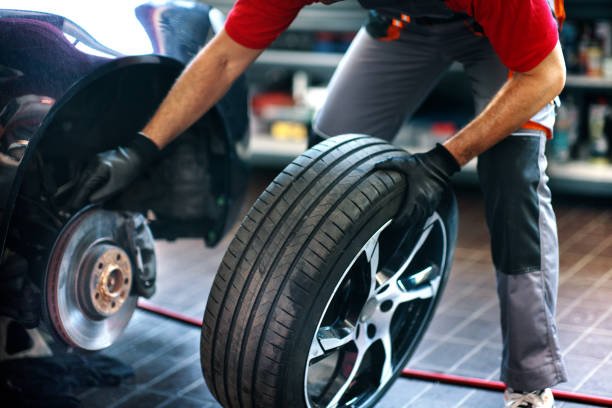What Are the Dangers of Overinflating a Tire?
Tire pressure plays a crucial role in vehicle safety, fuel efficiency, and overall performance. While many drivers are aware of the dangers of underinflation, overinflating a tire is equally hazardous.

Exceeding the recommended pressure levels can lead to serious consequences, from uneven tread wear to a heightened risk of blowouts. Understanding the risks of overinflation and maintaining proper tire pressure is essential for every vehicle owner.
Increased Risk of a Tire Blowout
One of the most dangerous consequences of overinflating a tire is the increased risk of a blowout. When a tire is overinflated, the air pressure within it exceeds the manufacturer’s recommended level, causing the rubber to stretch beyond its normal limits. This excessive pressure weakens the tire structure, making it more susceptible to damage from road hazards such as potholes, curbs, and debris.
A blowout at high speeds can lead to a sudden loss of control, endangering both the driver and others on the road. Unlike a slow leak, a blowout is immediate and often results in an accident. To prevent this, regularly checking and adjusting tire pressure to meet the manufacturer’s specifications is crucial.
Uneven and Premature Tread Wear
Proper tire pressure ensures even distribution of weight across the tread, promoting uniform wear. However, overinflated tires create a convex shape, causing the center of the tread to bear the brunt of the road contact. As a result, the tire wears out in the middle while the outer edges remain relatively untouched.
Uneven wear shortens the lifespan of your tires and reduces their effectiveness in maintaining traction, especially in wet or slippery conditions. Drivers who frequently overinflate their tires may find themselves replacing them more often, leading to unnecessary expenses.
Compromised Vehicle Handling and Stability
Tires are designed to provide optimal grip and stability based on their recommended pressure levels. Overinflation reduces the tire’s contact patch—the portion of the tire that touches the road—leading to decreased traction. This makes the vehicle more difficult to handle, especially when making sharp turns or sudden maneuvers.
Overinflated tires also impact braking performance. With less rubber in contact with the road, stopping distances increase, which can be dangerous in emergency situations. Ensuring proper tire pressure enhances vehicle stability, reducing the likelihood of skidding or losing control.
Harsher Ride Quality
One of the most noticeable effects of overinflated tires is a rougher ride. Since the air inside an overinflated tire is more compressed, it becomes less effective at absorbing shocks from bumps, potholes, and uneven road surfaces.
Drivers and passengers may experience increased vibrations and discomfort, leading to a less enjoyable ride. More importantly, excessive tire pressure can also strain the vehicle’s suspension system, causing premature wear on components like shock absorbers and struts.
Increased Stress on Suspension Components
The suspension system in a vehicle is designed to work in conjunction with properly inflated tires to provide a smooth and controlled ride. Overinflation reduces the tire’s ability to absorb impact, transferring more stress to the suspension components.
This added strain can lead to premature wear and tear on parts such as springs, shocks, and control arms. Over time, this can result in costly repairs and diminished ride quality. By keeping tires at the correct pressure, drivers can prolong the lifespan of their suspension system and maintain a more comfortable driving experience.
Reduced Fuel Efficiency
While some may believe that overinflated tires reduce rolling resistance and improve fuel efficiency, the reality is more complex. Although less surface contact with the road can lead to slightly reduced friction, it also compromises the tire’s ability to maintain proper grip and performance.
Poor traction forces the engine to work harder, especially in adverse weather conditions or on uneven terrain. This negates any potential fuel savings and may even increase fuel consumption in the long run. Maintaining manufacturer-recommended tire pressure ensures an optimal balance between efficiency and safety.
How to Avoid Overinflating Your Tires
Preventing overinflation is simple if you follow a few key steps:
-
Check Tire Pressure Regularly: Use a high-quality tire pressure gauge to monitor your tires at least once a month and before long trips.
-
Follow Manufacturer Recommendations: The correct tire pressure can be found in the owner’s manual or on a sticker inside the driver’s side door.
-
Avoid Guesswork: Never rely on visual inspection alone. A tire can appear properly inflated while actually being overinflated or underinflated.
-
Monitor Temperature Changes: Air expands with heat, so adjust tire pressure accordingly in hot weather to prevent overinflation.
-
Use a Reliable Air Pump: If inflating tires at a gas station, check the accuracy of the air pump to ensure you are not exceeding the recommended pressure.
When to Seek Professional Tire Repair Services
If you suspect your tires have been overinflated for an extended period or have sustained damage, it’s best to have them inspected by a professional. For those in Florida, Tire Repair services in Oakland Park, FL are readily available to assess tire conditions and provide necessary maintenance. Timely inspections and repairs can prevent costly replacements and enhance vehicle safety.
Expert Tire Repair and Maintenance in Oakland Park, FL
If you’re looking for reliable tire services, Rite Tire & Auto is your trusted destination for high-quality vehicle maintenance and repairs in Oakland Park, FL. Whether you need routine tire checks, puncture repairs, or a complete tire replacement, our expert team ensures that your car is in top condition with professional care and outstanding service.
Maintaining the right tire pressure is essential for vehicle performance, safety, and longevity. Overinflation can lead to a host of issues, from blowouts to suspension wear. By regularly checking your tires, following manufacturer guidelines, and seeking professional assistance when needed, you can avoid the dangers of overinflating a tire and ensure a safer driving experience.
What's Your Reaction?
















